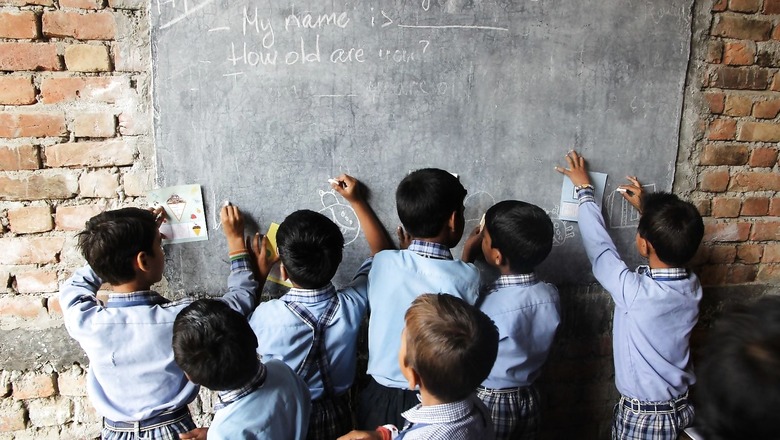Missed Opportunity: Almost 50% Students in Tribal Areas Drop Out of School Before Completing Class 8

views
Nearly half of the total children enrolled in schools in tribal areas — 48.2 per cent — drop out even before they complete Class 8, with more boys leaving their education midway, the Tribal Development Report, 2022, released by an independent body set up by the Centre, has revealed.
The body, which has been formulated to scale up action in these areas, also found that those reaching up to Class 10 or secondary level of education are fewer, with a cumulative dropout rate of 62.4 per cent. Overall, barely 40 per cent of Scheduled Tribes (ST) children who enrol in Class 1 actually reach Class 10 as they continue dropping out at various stages.
The dropout rates, especially in elementary classes in tribal areas of Chhattisgarh, Jharkhand, Madhya Pradesh, Rajasthan, and Odisha, are much higher than in other communities, the report — being claimed as the first such document tracking the development of tribal communities in the country — said.
The report was released on November 29 by the Bharat Rural Livelihoods Foundation (BRLF), an independent body set up by the Union Cabinet under the Ministry of Rural Development (MoRD) in 2013. It focuses on Schedule V areas (states which have significant Scheduled Tribes population) — Andhra Pradesh (including Telangana), Jharkhand, Chhattisgarh, Himachal Pradesh, Madhya Pradesh, Gujarat, Odisha, and Rajasthan.
At present, the dropout rate in schools in tribal areas is 31.3 per cent (31.9 per cent male, 30.7 per cent female) with more boys dropping out of school than girls. A worrying trend has been the dropout rate in the elementary cycle (classes 1-8) with 48.2 per cent children (49.8 per cent males, 46.4 per cent females) leaving school, it states.
For those who do enter secondary education, at the end of Class 10, 63.2 per cent male students and 61.4 per cent female students dropped out. “There is also a noticeable gap between ST, SC, and all communities, with the status of ST being most challenging,” said Vimala Ramachandran, educational researcher and retired professor of teacher management, National Institute of Educational Planning and Administration (NIEPA), who has authored the paper on status of education in this report.
What are the reasons?
According to Ramachandran, since Independence, numerous committees have been set up to look into the issues and have recommended similar interventions but lack of political resolve hindered their implementation.
“Most of the central government programmes are designed for the country as a whole. They are not tailored for the needs of specific groups, which are often in the face of conflict and displacement,” she said.
The use of mother tongue as a medium of instruction in primary classes in tribal areas — where the language of the state may be different from the tribal dialect — was suggested at several instances, with the latest being the New Education Policy (NEP), 2020, which focuses on use of ‘home language’ in foundational classes. However, there are no multi-lingual texts available to teach children in these areas.
“Also, the teachers are mostly on contract and do not have access to training or pedagogy skills to teach even classes 3-4. They are mostly outsiders and hence do not know the home language. There is a huge social distance between student and teacher as it has been observed that the latter has a prejudice that tribal children are not capable of learning. After Class 10, science and commerce are not taught due to shortage of teachers who can teach maths and science. These areas have a large number of small or one-two teacher schools (with less than 50 students) and need more human resources,” she said.
Ramachandran added: “A high-level committee consisting of ministries of tribal affairs and education needs to review existing schemes and strategies to encourage school and higher education among STs. It also needs to set up joint mechanisms at the state level to review implementation. A time-bound and focused plan is required to expand the pool of trained teachers in math, science, commerce and environmental sciences.”
‘Out of School Children’
The report highlights the findings of a national study carried out by the ministry of education in 2014 on ‘out of school children (OOSC)’. STs, who constitute 8.6 per cent of the population (as per 2011census), accounted for 11 per cent OOSC in the country.
“OOSC ST children are more prominent in the 11–13 age group, confirming the findings of other data sources that a disproportionately larger number of ST children drop out at the upper primary and higher levels. States like Rajasthan (24 per cent male, 38.8 per cent females) and Odisha (23 per cent male, 26 per cent females) record very high percentage of OOSC in this age group,” the report said.
Disaggregation by social groups shows that the maximum proportion of out-of-school children in India is within Scheduled Tribes (4.20 per cent), followed by Scheduled Caste (3.24 per cent) and Others (1.84 per cent).
In absolute numbers, 10,07,562 ST children are out of school (9,25,193 rural and 82,369 urban). In rural areas, the number of ST boys who are out of school in the 6–13 age group is marginally higher than that of girls (4,90,483 boys, 4,34,710 girls). Similarly, in urban areas, more ST boys are out of school than girls (41,648 boys and 40,721 girls), the report stated.
With economically poorer states having a lower percentage of students enrolled in higher education, the most recently created tribal states of Chhattisgarh and Jharkhand show a far bleaker picture. The gross enrolment of students from STs in 2015–16 was 13.7 per cent while those of scheduled castes (SC) students is 19.1 per cent. “This means for every ST or SC student who manages to enter a college or a higher education institution, from scheduled tribes (STs) there are four others who have missed the opportunity,” it stated.
Read all the Latest Education News here




















Comments
0 comment